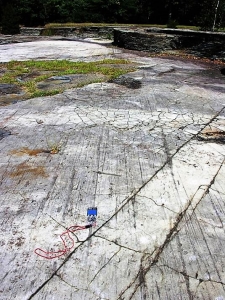An Ice Age Opus?
On the Rocks, The Woodstock Times; April 11, 2011
Updated by Robert and Johanna Titus
Opus 40 is one of the strangest and most truly unique sculptures to be seen anywhere. It was the concept and, perhaps, obsession of Harvey Fite who worked on it from 1939 to 1976 when he died with his boots on, still at work on his creation. The site had been, originally, just another abandoned bluestone quarry in an area with very many of them. If you spend enough time exploring, you can find them all over the place. They lie off in the woods, almost buried in the forests. They are landscape scars, slowly healing from the commercial wounds of a onetime important bluestone industry.
Almost all the others have been left to become overgrown. But Fite had something else in mind. He spent decades moving rocks and boulders around to create his sculpture. Had he been doing this as an inmate at some prison, it would have been a scandalous example of the abuse of “hard labor.” Perhaps Fite might have been among those who protested such an injustice, but he was the one who inflicted this hard labor upon himself. Sadly, he did not live to see his hard labor completed and, in many ways, it remains a “work in progress.” Was this a mission, an obsession, or just what it was supposed to be: a work of art? Who knows, but it’s quite the place to visit.
The current owners (2011) of Opus 40 are interested in selling the property. One proposal floating around is for the town of Saugerties to buy it and turn the place into a park. It’s a controversial notion, especially in these economically depressed times. It’s not any of our business what the people of Saugerties choose to do or not to do, but it is our business to speak of the geology there.
And, in fact, we always like to poke our nose into local affairs – when there is a geological angle, so this was just too good to pass by. We went and visited the site. Our interest wasn’t art; it was the geology. The Opus 40 quarry displays a cross section of all Catskills geological, right there in one spot. It’s one stop shopping for a Catskill geologist.

It’s more than just bedrock; there is a fine glaciated surface that surrounds the quarry. You can circumnavigate the quarry and find yourself walking on a smooth, flat platform of rock. Here we see a wonderful example of what we have sometimes called a “dance floor.” That’s rock surface that was sanded and polished by the passage of the ice back during the Ice Age. Harvey Fite was not the first sculptor to work here. The Hudson Valley glacier got there more than 20,000 years earlier. As the glacier passed across this surface, it dragged along tons of cobble-rich sand and gravel. These materials beveled off the native rock; then the sand ground down the surface and even polished it.
The gravel and cobbles scratched striations onto the polished surface. The striations have a compass direction – south, 20 degrees west – and that speaks to us of the path the glacier took as it headed across the site. We like to stand in such a place and look in the direction that the striations indicate. In our mind’s eyes we can see a barren landscape all around. We stand in a “forest” of bare tree trunks. All of them rise above the ground for 20 feet or more, but none of them have any foliage. These tree trunks are dead; they rise to splintered tops; all have been decapitated by fierce Ice Age gales.
At such a moment we have traveled back to the Ice Age, at least the early stages of that chapter in our history. The climate has suffered from the onset of very cold times. All the trees, and for that matter, all of the rest of the plants have died. There is nothing alive at all, not a mammal, reptile or bird. This is a forest of the dead.
We are the mind’s eyes, the human imagination, and we can do anything we wish. We rise up into the sky a thousand feet and gaze off north, 20 degrees east. There, not all that far away, is the advancing Hudson Valley glacier. It spreads across the landscape and the front of the ice looms tall above the dead forest. This is a dry glacier; it is not melting; it is too cold for that.
But it is moving, slowly, the way a glacier should. And it is advancing toward what will someday be Woodstock. We listen intently and we hear sporadic cracking sounds, slow low-toned grinding noises and loud pops. The brittle ice, shoved from behind by hundreds of miles of more ice, is lurching forward – towards us. Soon, it will help shape the Woodstock that you know today.
Then, suddenly, we return to the present day. We stand at the edge of Harvey Fite’s life’s work and gaze all around. That platform is the focus of our attention. We understand it all so much the better now. It’s a fine dance floor and maybe worth the visit all by itself, but there is more, there is the bedrock. We will visit that in the next article.
Contact the authors at randjtitus@prodigy.net. Join their facebook page “The Catskill Geologist.”





